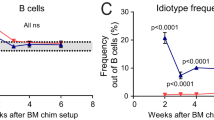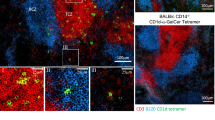Abstract
The lymphoid organs contain specialized microanatomic structures composed of lymphoid, myeloid and stromal cells that are vital to the generation of an effective adaptive immune response. Although the existence of these specialized structures has been known for over a century, the developmental signals that generate them and the specific roles of these structures in the immune response have remained largely elusive. Because of their position adjacent to the marginal sinuses, marginal zone B (MZB) cells are amongst the first population of cells seen by blood born antigens and are presumed to have a critical role in host defense against bacterial pathogens. Here we demonstrate that a deficiency of the tyrosine kinase (Pyk-2) results in a cell autonomous defect of MZB cell production. In response to repetitive polysaccharide antigens (T-independent type II (TI-II)) Pyk-2–deficient mice displayed marked suppression of IgM, IgG3 and IgG2a production. Furthermore, complement receptor engagement proved necessary for the specific targeting of polysaccharide antigens to MZB cells. These results suggest how innate immune responses mediated through complement coupling are translated into an adaptive response by MZB cells, and provide a potential mechanism for the T cell independence of humoral responses to polysaccharide antigens.
This is a preview of subscription content, access via your institution
Access options
Subscribe to this journal
Receive 12 print issues and online access
$209.00 per year
only $17.42 per issue
Buy this article
- Purchase on Springer Link
- Instant access to full article PDF
Prices may be subject to local taxes which are calculated during checkout





Similar content being viewed by others
References
MacLennan, I.C. B-cell receptor regulation of peripheral B cells. Curr. Opin. Immunol. 10, 220–225 (1998).
Guinamard, R. et al. B cell antigen receptor engagement inhibits stromal cell-derived factor (SDF)-1alpha chemotaxis and promotes protein kinase C (PKC)-induced internalization of CXCR4. J. Exp. Med. 189, 1461–1466 (1999).
Bleul, C.C., Schultze, J.L. & Springer, T.A. B lymphocyte chemotaxis regulated in association with microanatomic localization, differentiation state, and B cell receptor engagement. J. Exp. Med. 187, 753–762 (1998).
Forster, R. et al. A putative chemokine receptor, BLR1, directs B cell migration to defined lymphoid organs and specific anatomic compartments of the spleen. Cell 87, 1037–1047 (1996).
Ma, Q. et al. Impaired B-lymphopoiesis, myelopoiesis, and derailed cerebellar neuron migration in CXCR4- and SDF-1-deficient mice. Proc. Natl Acad. Sci. USA 95, 9448–9453 (1998).
Lalor, P.A. & Morahan, G. The peritoneal Ly-1 (CD5) B cell repertoire is unique among murine B cell repertoires. Eur. J. Immunol. 20, 485–492 (1990).
Oliver, A.M., Martin, F. & Kearney, J.F. IgMhighCD21high lymphocytes enriched in the splenic marginal zone generate effector cells more rapidly than the bulk of follicular B cells. J.Immunol. 162, 7198–7207 (1999).
Kawabe, T. et al. The immune responses in CD40-deficient mice: impaired immunoglobulin class switching and germinal center formation. Immunity 1, 167–178 (1994).
Hayakawa, K., Hardy, R.R., Parks, D.R. & Herzenberg, L.A. The “Ly-1 B” cell subpopulation in normal immunodefective, and autoimmune mice. J. Exp. Med. 157, 202–218 (1983).
Qin, X.F., Reichlin, A., Luo, Y., Roeder, R.G. & Nussenzweig, M.C. OCA-B integrates B cell antigen receptor-, CD40L- and IL 4-mediated signals for the germinal center pathway of B cell development. EMBO J. 17, 5066–5075 (1998).
Dikic, I., Tokiwa, G., Lev, S., Courtneidge, S.A. & Schlessinger, J. A role for Pyk2 Src in linking G-protein-coupled receptors with MAP kinase activation. Nature 383, 547–550 (1996).
Lev, S. et al. Protein tyrosine kinase PYK2 involved in Ca(2+)-induced regulation of ion channel and MAP kinase functions [see comments]. Nature 376, 737–745 (1995).
Lev, S. et al. Identification of a novel family of targets of PYK2 related to Drosophila retinal degeneration B (rdgB) protein. Mol. Cell Biol. 19, 2278–2288 (1999).
Davis, C.B. et al. Signal transduction due to HIV-1 envelope interactions with chemokine receptors CXCR4 or CCR5. J. Exp. Med. 186, 1793–1798 (1997).
Ma, E.A., Lou, O., Berg, N.N. & Ostergaard, H.L. Cytotoxic T lymphocytes express a beta3 integrin which can induce the phosphorylation of focal adhesion kinase and the related PYK2. Eur. J. Immunol. 27, 329–335 (1997).
Okigaki, M. et al. Pyk2 regulates multiple signalling events crucial for macrophage morphology, migration and function. Nature Cell Biol. (Submitted).
Ma, Q., Jones, D. & Springer, T.A. The chemokine receptor CXCR4 is required for the retention of B lineage and granulocytic precursors within the bone marrow microenvironment. Immunity 10, 463–471 (1999).
Zou, Y.R., Kottmann, A.H., Kuroda, M., Taniuchi, I. & Littman, D.R. Function of the chemokine receptor CXCR4 in haematopoiesis and in cerebellar development [see comments]. Nature 393, 595–599 (1998).
Tachibana, K. et al. The chemokine receptor CXCR4 is essential for vascularization of the gastrointestinal tract [see comments]. Nature 393, 591–594 (1998).
Nagasawa, T. et al. Defects of B-cell lymphopoiesis and bone-marrow myelopoiesis in mice lacking the CXC chemokine PBSF/SDF-1. Nature 382, 635–638 (1996).
Oliver, A.M., Martin, F., Gartland, G.L., Carter, R.H. & Kearney, J.F. Marginal zone B cells exhibit unique activation, proliferative and immunoglobulin secretory. Eur. J. Immunol. 27, 2366–2374 (1997).
Roark, J.H. et al. CD1.1 expression by mouse antigen-presenting cells and marginal zone B cells. J. Immunol. 160, 3121–3127 (1998).
Smith, K.G., Hewitson, T.D., Nossal, G.J. & Tarlinton, D.M. The phenotype and fate of the antibody-forming cells of the splenic foci. Eur. J. Immunol. 26, 444–448 (1996).
Lane, P.J., Gray, D., Oldfield, S. & MacLennan, I.C. Differences in the recruitment of virgin B cells into antibody responses to thymus-dependent and thymus-independent type-2 antigens. Eur. J. Immunol. 16, 1569–1575 (1986).
Ilgen, C.L., Bossen, E.H., Rowlands, D.T.J. & Burkholder, P.M. Isolation and characterization of C4-synthesizing cells from guinea-pig spleen. Immunology 26, 659–665 (1974).
Ochsenbein, A.F. et al. Protective T cell-independent antiviral antibody responses are dependent on complement. J. Exp. Med. 190, 1165–1174 (1999).
Dempsey, P.W., Allison, M.E., Akkaraju, S., Goodnow, C.C. & Fearon, D.T. C3d of complement as a molecular adjuvant: bridging innate and acquired immunity. Science 271, 348–350 (1996).
Inaoki, M., Sato, S., Weintraub, B.C., Goodnow, C.C. & Tedder, T.F. CD19-regulated signaling thresholds control peripheral tolerance and autoantibody production in B lymphocytes. J. Exp. Med. 186, 1923–1931 (1997).
Campbell, J.J. et al. Chemokines and the arrest of lymphocytes rolling under flow conditions. Science 279, 381–384 (1998).
Liakka, K.A. The integrin subunits alpha 2, alpha 3, alpha 4, alpha 5, alpha 6, alpha V, beta 1 and beta 3 in fetal, infant and adult human spleen as detected by immunohistochemistry. Differentiation 56, 183–190 (1994).
Gunn, M.D. et al. A B-cell-homing chemokine made in lymphoid follicles activates Burkitt's lymphoma receptor-1. Nature 391, 799–803 (1998).
Opstelten, D., Niewiadomska, A., Kwong, A.Y.H. & Nagasawa, T. Proc. 10th Int. Congr. Immunol. 63–69 (1998).
Makowska, A., Faizunnessa, N.N., Anderson, P., Midtvedt, T. & Cardell, S. CD1high B cells: a population of mixed origin. Eur. J. Immunol. 29, 3285–3294 (1999).
Rickert, R.C., Rajewsky, K. & Roes, J. Impairment of T-cell-dependent B-cell responses and B-1 cell development in CD19-deficient mice. Nature 376, 352–355 1995).
Scher, I. The CBA/N mouse strain: an experimental model illustrating the influence of the X-chromosome on immunity. Adv. Immunol. 33, 1–71 (1982).
Prior, L., Pierson, S., Woodland, R.T. & Riggs, J. Rapid restoration of B-cell function in XID mice by intravenous transfer of peritoneal cavity B cells. Immunology 83, 180–183 (1994). (Published erratum appears in Immunology 84, 172 (1995).)
Carroll, M.C. & Prodeus, A.P. Linkages of innate and adaptive immunity. Curr. Opin. Immunol. 10, 36–40 (1998).
Takai, T., Ono, M., Hikida, M., Ohmori, H. & Ravetch, J.V. Augmented humoral and anaphylactic responses in Fc gamma RII-deficient mice. Nature 379, 346–349 (1996).
Acknowledgements
We are grateful for the comments of R. Steinman and M. Nussenzweig on this manuscript and for the assistance provided by P. Kaloudis and C. Ritter in preparing it. These studies were supported by grants from the NIH . R.G. is a fellow of the Irvington Institute for Immunology.
Author information
Authors and Affiliations
Corresponding author
Rights and permissions
About this article
Cite this article
Guinamard, R., Okigaki, M., Schlessinger, J. et al. Absence of marginal zone B cells in Pyk-2–deficient mice defines their role in the humoral response. Nat Immunol 1, 31–36 (2000). https://doi.org/10.1038/76882
Received:
Accepted:
Issue Date:
DOI: https://doi.org/10.1038/76882
This article is cited by
-
An integrated proteome and transcriptome of B cell maturation defines poised activation states of transitional and mature B cells
Nature Communications (2023)
-
IKKα deficiency disrupts the development of marginal zone and follicular B cells
Genes & Immunity (2019)
-
The emerging role of ADAM metalloproteinases in immunity
Nature Reviews Immunology (2018)
-
Transitional B cells commit to marginal zone B cell fate by Taok3-mediated surface expression of ADAM10
Nature Immunology (2017)
-
Marginal zone B cells exacerbate endotoxic shock via interleukin-6 secretion induced by Fcα/μR-coupled TLR4 signalling
Nature Communications (2016)



